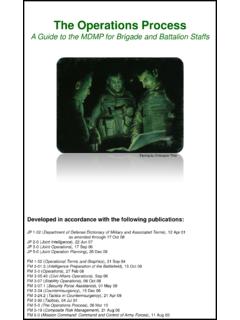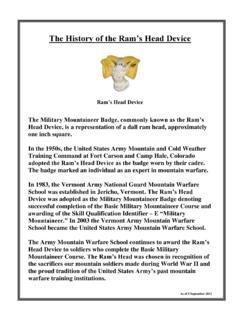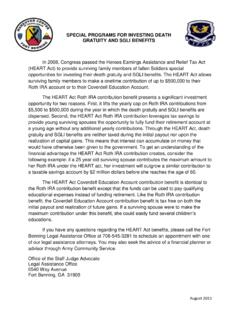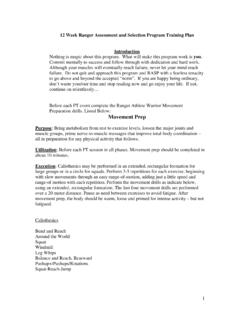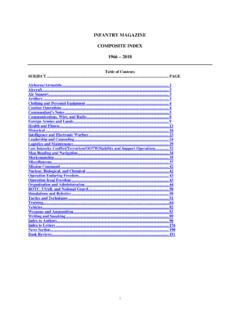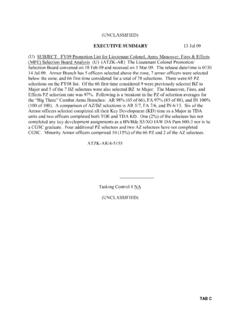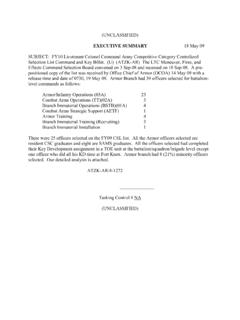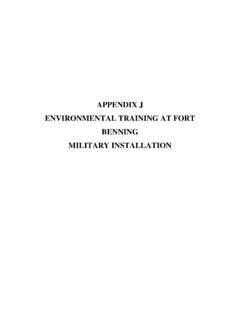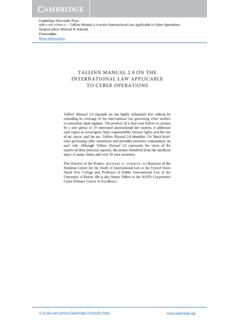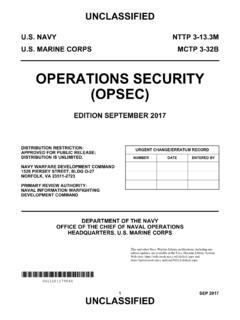Transcription of JP 3-0, Joint Operations - United States Army
1 11 August 2011 Joint OperationsJoint Publication 3-0 This revised edition of Joint Publication 3-0, Joint Operations , reflects the current guidance for conducting Joint activities across the range of military Operations and is the basis for participation in multinational Operations where the United States has not ratified specific doctrine or procedures. This keystone publication forms the core of Joint warfighting doctrine and establishes the framework for our forces ability to fight as a Joint team. Often called the linchpin of the Joint doctrine publication hierarchy, the overarching constructs and principles contained in this publication provide a common perspective from which to plan and execute Joint Operations independently or in cooperation with our multinational partners, other Government departments and agencies, and intergovernmental and nongovernmental organizations.
2 As our Nation continues into the 21st century, the guidance in this publication will enable current and future leaders of the Armed Forces of the United States to design, plan, organize, train for, and execute worldwide missions as our forces transform to meet emerging challenges. To succeed, we need adaptive and thinking professionals who understand the capabilities their Service brings to Joint Operations ; how to integrate those capabilities with those of the other Services and interorganizational partners to optimize the strength of unified action; and how to organize, employ, and sustain Joint forces to provide national leaders with multiple options for addressing various security threats.
3 Above all, we need professionals imbued with a sense of commitment and honor who will act decisively in the absence of specific guidance. I challenge all commanders to ensure the widest distribution of this keystone Joint publication and actively promote the use of all Joint publications at every opportunity. I further challenge you to study and understand the guidance contained in this publication and teach these principles to your subordinates. Only then will we be able to fully exploit the remarkable military potential inherent in our Joint teams. M. G. MULLEN Admiral, Navy i PREFACE 1. Scope This publication is the keystone document of the Joint Operations series.
4 It provides the doctrinal foundation and fundamental principles that guide the Armed Forces of the United States in Joint Operations across the range of military Operations . 2. Purpose This publication has been prepared under the direction of the Chairman of the Joint Chiefs of Staff. It sets forth Joint doctrine to govern the activities and performance of the Armed Forces of the United States in Joint Operations , and it provides considerations for military interaction with governmental and nongovernmental agencies, multinational forces, and other interorganizational partners. It provides military guidance for the exercise of authority by combatant commanders and other Joint force commanders (JFCs), and prescribes Joint doctrine for Operations and training.
5 It provides military guidance for use by the Armed Forces in preparing and executing their plans and orders. It is not the intent of this publication to restrict the authority of the JFC from organizing the force and executing the mission in a manner the JFC deems most appropriate to ensure unity of effort in the accomplishment of objectives. 3. Application a. Joint doctrine established in this publication applies to the Joint staff, commanders of combatant commands, subunified commands, Joint task forces, subordinate components of these commands, and the Services. b. The guidance in this publication is authoritative; as such, this doctrine will be followed except when, in the judgment of the commander, exceptional circumstances dictate otherwise.
6 If conflicts arise between the contents of this publication and the contents of Service publications, this publication will take precedence unless the Chairman of the Joint Chiefs of Staff, normally in coordination with the other members of the Joint Chiefs of Staff, has provided more current and specific guidance. Commanders of forces operating as part of a multinational (alliance or coalition) military command should follow multinational doctrine and procedures ratified by the United States . For doctrine and procedures not ratified by the US, commanders should evaluate and follow the multinational command s doctrine and procedures, where applicable and consistent with US law, regulations, and doctrine.
7 Preface ii JP 3-0 Intentionally Blank iii SUMMARY OF CHANGES REVISION OF Joint PUBLICATION 3-0, DATED 17 SEPTEMBER 2006 (INCORPORATING CHANGE 2 DATED 22 MARCH 2010) Incorporates a discussion of the art of Joint command, including new ideas on command-centric leadership and operational design. Incorporates a new section on creating shared understanding, which emphasizes the interaction of information management and knowledge sharing to create an organizational environment of learning that facilitates Joint Operations . Consolidates information related to organizing for Joint Operations in a single Chapter IV.
8 Consolidates Chapters V, VI, and VII in a single Chapter V. Reduces redundancies and improves continuity between Joint Publication (JP) 3-0 and JP 1, Doctrine for the Armed Forces of the United States . Reduces redundancies and improves continuity between JP 3-0 and JP 5-0, Joint Operation Planning. Summary of Changes iv JP 3-0 Intentionally Blank v TABLE OF CONTENTS PAGE EXECUTIVE SUMMARY .. ix CHAPTER I FUNDAMENTALS OF Joint Operations Introduction .. I-1 Strategic Environment and National Security Challenges .. I-2 Instruments of National Power and the Range of Military Operations .. I-4 Strategic Guidance.
9 I-5 Unified Action .. I-8 Levels of War .. I-12 Types of Military I-14 CHAPTER II THE ART OF Joint COMMAND Introduction ..II-1 Commander-Centric Leadership ..II-1 Operational Art ..II-3 Operational Design ..II-4 Joint Operation Planning ..II-5 Assessment ..II-9 CHAPTER III Joint FUNCTIONS Introduction .. III -1 Command and Control .. III -2 Intelligence .. III -20 Fires .. III -22 Movement and Maneuver .. III -27 Protection .. III -29 Sustainment .. III -35 CHAPTER IV ORGANIZING FOR Joint Operations Introduction .. IV-1 Understanding the Operational Environment .. IV-1 Organizing the Joint Force.
10 IV-6 Organizing the Joint Force Headquarters .. IV-10 Organizing Operational Areas .. IV-11 Table of Contents vi JP 3-0 CHAPTER V Joint Operations ACROSS THE RANGE OF MILITARY Operations Introduction .. V-1 Section A. Types of Military Operations .. V-3 Military Operations and Related Missions, Tasks, and Actions .. V-3 Section B. A Phasing Construct .. V-5 Phasing a Joint Operation .. V-5 Section C. Military Engagement, Security Cooperation, and Deterrence .. V-9 Military Engagement, Security Cooperation, and Deterrence .. V-9 Typical Operations .. V-11 Other Considerations .. V-18 Section D. Crisis Response and Limited Contingency Operations .
